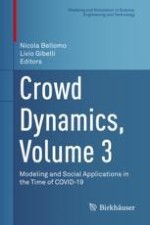This contributed volume explores innovative research in the modeling, simulation, and control of crowd dynamics. Chapter authors approach the topic from the perspectives of mathematics, physics, engineering, and psychology, providing a comprehensive overview of the work carried out in this challenging interdisciplinary research field. In light of the recent COVID-19 pandemic, special consideration is given to applications of crowd dynamics to the prevention of the spreading of contagious diseases. Some of the specific topics covered in this volume include:
- Impact of physical distancing on the evacuation of crowds- Generalized solutions of opinion dynamics models- Crowd dynamics coupled with models for infectious disease spreading- Optimized strategies for leaders in controlling the dynamics of a crowd
Crowd Dynamics, Volume 3 is ideal for mathematicians, engineers, physicists, and other researchers working in the rapidly growing field of modeling and simulation of human crowds.
